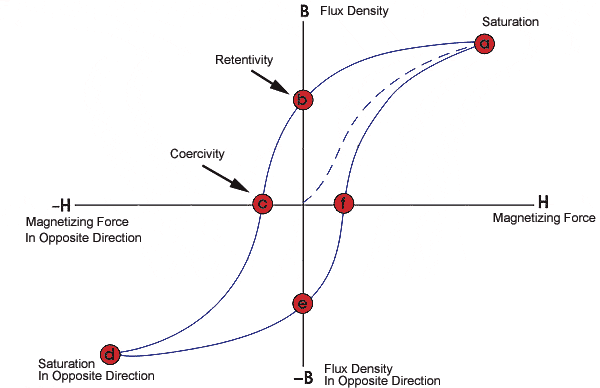|
The
Hysteresis Loop
and Magnetic Properties
A great deal of information can be learned about
the magnetic properties of a material by studying its hysteresis
loop. A hysteresis loop shows the relationship between the induced
magnetic flux density B and the magnetizing force H.
It is often referred to as the B-H loop. An example hysteresis
loop is shown below.

The loop is generated by measuring the magnetic
flux B of a ferromagnetic material while the magnetizing
force H is changed. A ferromagnetic material that has never
been previously magnetized or has been thoroughly demagnetized
will follow the dashed line as H is increased. As the line
demonstrates, the greater the amount of current applied (H+),
the stronger the magnetic field in the component (B+).
At point "a" almost all of the magnetic domains are
aligned and an additional increase in the magnetizing force will
produce very little increase in magnetic flux. The material has
reached the point of magnetic saturation. When H is reduced
back down to zero, the curve will move from point "a"
to point "b." At this point, it can be seen that some
magnetic flux remains in the material even though the magnetizing
force is zero. This is referred to as the point of retentivity
on the graph and indicates the remanence or level of residual
magnetism in the material. (Some of the magnetic domains remain
aligned but some have lost there alignment.) As the magnetizing
force is reversed, the curve moves to point "c", where
the flux has been reduced to zero. This is called the point of
coercivity on the curve. (The reversed magnetizing force has flipped
enough of the domains so that the net flux within the material
is zero.) The force required to remove the residual magnetism
from the material, is called the coercive force or coercivity
of the material.
As the magnetizing force is increased in the negative
direction, the material will again become magnetically saturated
but in the opposite direction (point "d"). Reducing
H to zero brings the curve to point "e." It will
have a level of residual magnetism equal to that achieved in the
other direction. Increasing H back in the positive direction
will return B to zero. Notice that the curve did not return
to the origin of the graph because some force is required to remove
the residual magnetism. The curve will take a different path from
point "f" back the saturation point where it with complete
the loop.
From the hysteresis loop, a number of primary magnetic
properties of a material can be determined.
- Retentivity - A measure of the residual flux density
corresponding to the saturation induction of a magnetic material.
In other words, it is a material's ability to retain a certain
amount of residual magnetic field when the magnetizing force
is removed after achieving saturation. (The value of B
at point B on the hysteresis curve.)
- Residual Magnetism or Residual Flux - the
magnetic flux density that remains in a material when the
magnetizing force is zero. Note that residual magnetism and
retentivity are the same when the material has been magnetized
to the saturation point. However, the level of residual magnetism
may be lower than the retentivity value when the magnetizing
force did not reach the saturation level.
- Coercive Force - The amount of reverse magnetic field
which must be applied to a magnetic material to make the magnetic
flux return to zero. (The value of H at point C on
the hysteresis curve.)
- Permeability, m - A property
of a material that describes the ease with which a magnetic
flux is established in the component.
- Reluctance - Is the opposition that a ferromagnetic
material shows to the establishment of a magnetic field. Reluctance
is analogous to the resistance in an electrical circuit.
|